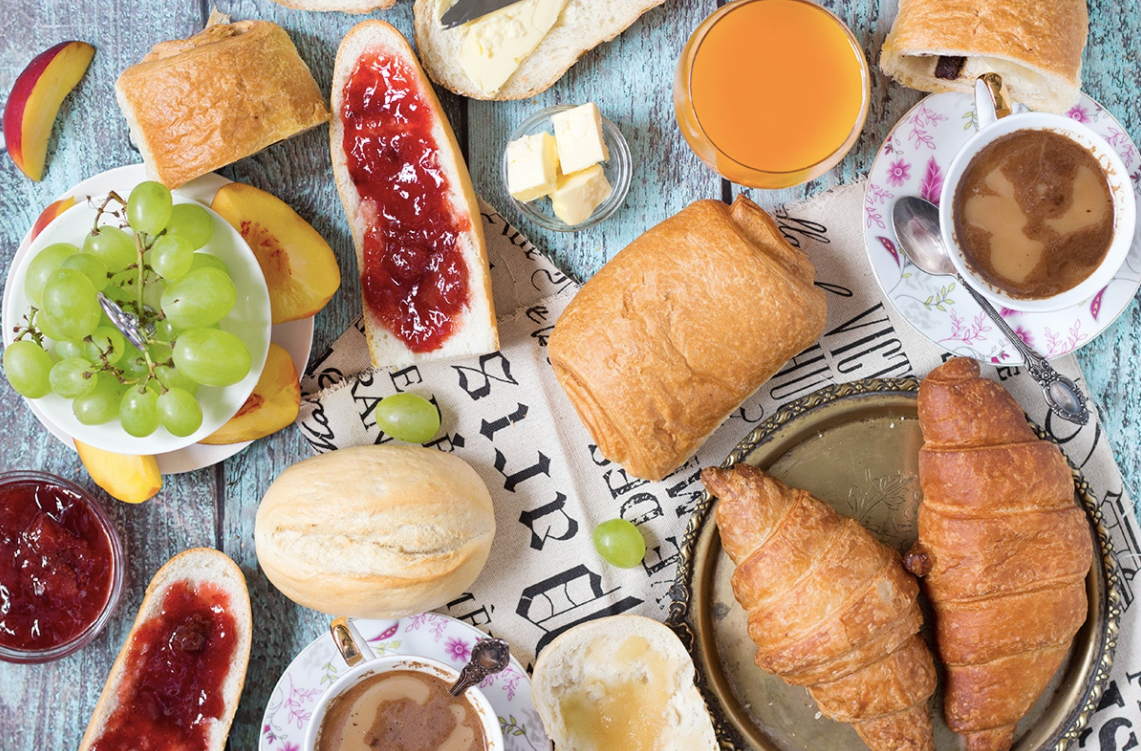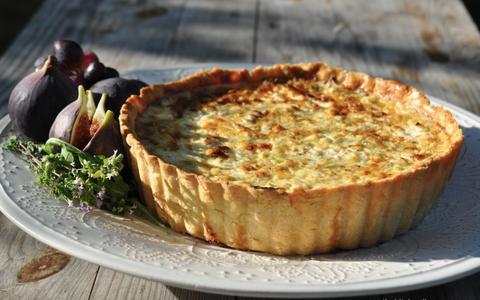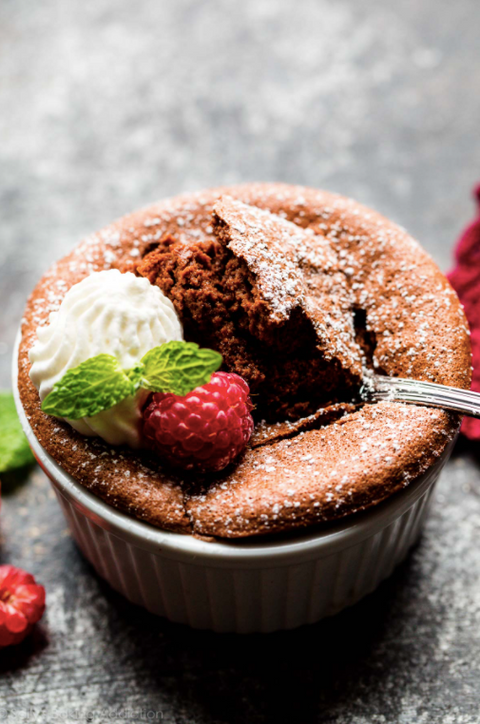The French meal structure is different, and many people have trouble understanding how it works. For example, many people who were never exposed to it (and may not have traveled much) have no idea what to do when offered a salad after the main course.
The French notion of lunch and dinner is different from that of the English-speaking world. The first course (Entrée) would be equivalent to American appetizers, but we'll talk about that later.
The main course is one dish, often with side dishes, like potatoes, rice or pasta. These are generally included in French restaurants in France in the main course cost. So you don't order "a steak" with "a side of potatoes"; you call "a steak," and you get some potatoes with it. If they serve salad, it's included in the main course price.
Breakfast
The traditional French breakfast is usually small and light. Bread such as croissants, brioche, and baguettes with jam, butter, Nutella, or toast with coffee or hot chocolate is common. Breakfast is usually eaten in a hurry before work or school, but it's also worth experiencing the leisurely weekend breakfast - coffee and croissants accompanied by newspapers - at a French cafe.
Lunch
French lunch means a sit-down meal at noon. In the United States, it's all about the baguette and the sandwich, but in France, there's often more to lunch than that. So when you take your first bite of a croissant or open that baguette and taste that flaky crust, you're eating a piece of Paris.
French lunch is not only about food — but it's also about how you eat it.
A good French lunch has three parts:
- An appetizer (usual soup)
- Main course (usually meat)
- And dessert (usually fruit)
The appetizer is generally small and light, so the main method doesn't weigh you down; it's meant to be enjoyed with conversation. Dessert is typically something sweet — fresh fruit for dessert isn't common in France.
The traditional French lunch is a light meal, often salads and grilled meats or fish. But there is more to the French lunch than just those two things. The main ingredients in a French lunch are meat, fish, cheese, and salads.
Dinner
In French culture, dinner is the last and most important meal. It is generally served between 7:00 p.m. and 9:00 p.m., but it can be as early as 6:00 p.m. if you live in Paris or another large city with active nightlife. Like lunch, dinner consists of three courses: a starter (one entrée), the main course (le plat principal), and cheese or dessert. After dinner, coffee and an aperitif are sometimes served later in the evening between 9:00 p.m. and 11:00 p.m.
Paris is home to some of the world’s finest and most diverse haute cuisine, and from the historic baguette and bistro fare to fusion tapas and modern French gastronomy and you have to try these meals with the help of taste website.
Dining out in Paris is an integral part of the city's culture. Many of the city's best restaurants are driven by a passion for seasonality and quality ingredients, with a deep respect for French culinary tradition.
Traditional French lunches are simple affairs:
- You don't go to a restaurant to eat complicated dinners like osso buco or lobster thermidor.
- Instead, you go for the sandwich made of steak-frites (steak with fries) or some tartare. And though you might order faroille, a sauce made from roasted vegetables, it's not a must-have item at every meal.
A typical French lunch usually includes one or two types of salads, but if you want to try something different, ask for your choice of dressing (from the Marinières, the standard vinaigrette, to the vinaigrette.
Appetizers
In France, an entrée describes a dish eaten before the main course. In this sense, an entrée is similar to an appetizer. However, English-speaking chefs have also adopted the word to describe a dish eaten before or after the main course.
In French cuisine, an entrée can be a cold plate of charcuterie and cheese, a seafood dish such as bouillabaisse (a fish stew), or a hot dish such as moules Marinières (mussels in white wine sauce). In most formal French dinners consisting of multiple courses, there will be two entrées: one cold, one hot.
Appetizers are a very important part of the French meal Such as;
- The first course, or entrée (on-tray), might be as simple as a bowl of soup, or it could be a salad, an omelet, or even a small roast chicken.
- Whatever it is, it can easily be a full meal in itself. Appetizers are usually cold foods like mousse, pâté, cheese, and charcuterie.
- If you think these foods sound heavy, you'd be right. That's why they're eaten at the beginning of the meal when your appetite is sharpest. You don't want to fill up on them, so it's important to pace yourself and not eat too much.
- What's more, most appetizers are either salty or fatty or both, which means they make you thirsty. So it would be best if you drank before the main course arrives — which is exactly what the French do with their aperitifs.
The main course, or le plat principal, is the heartiest part of a French lunch and around which the entire meal is built.
A typical main course may be meat or fish, with potatoes or rice and vegetables on the side. For instance, a person may order a steak with Pommes frites and a side salad. Or they could order grilled salmon with green beans and rice.
The main course will be cheese (le fromage) and a dessert (le dessert).

Desserts in French Lunch
In the French lunch, desserts are puddings like custards, flans, and mousses, plus fruit.
The most popular dessert is Custard dessert.
- Custard is a cooked mixture of milk or cream and egg yolk.
- Sometimes sugar and vanilla are also added. Custard is used as a filling in pastries and eaten as a dessert on its own.
- A typical French custard recipe contains egg yolks, sugar, milk or cream, and vanilla essence. The mixture is prepared by heating it slowly until it thickens. Custard may be baked (creme caramel) or unbaked (creme brulee).
A typical French dinner has three courses: a starter, the main course (plat principal), and cheese. Many times, you'll also have a small dessert to finish off your meal and look here to get help from familysearch website.
The entrée is followed by plats principaux (lit. "main dishes"), which are usually meat or fish dishes; then come les fromages (cheeses), followed by dessert.
Le Plat Principal (The Main Course)
While the main dish of a traditional French dinner is usually meat or fish, it can be vegetarian in some homes. French people are not as attached to their meats as Americans are — you can find them eating pasta or rice just as often as steak.
In many regions of France, people like to eat their main meal at lunchtime and eat lighter meals in the evening (this includes both children and adults). The idea is that lunch gives you energy for the afternoon, and dinner allows for better sleep. This is why it's common for restaurants to offer a prix fixe lunch menu from Monday to Friday and be closed for dinner during that time.
Le Fromage (Cheese)
French people love their cheese! It's common for people to ask for the specific type of cheese they want after finishing their main course, but it's also acceptable to leave it up to the chef or waiter.
Desserts are usually not as elaborate as in other countries, but they're still delicious.
French food is more than just the most popular cuisine globally; it's also a cultural touchstone. How you eat your meal says a lot about where you come from and can reveal you to others. The way that people in France eat their meals is very particular, and if you want to eat French food like a local (or be one), then there are some important rules of etiquette to keep in mind. Here are some of the most important ones:
Don't Eat Before Everyone Has Been Served
Meals are social events, and waiting for everyone to get served before starting to eat is not only polite but necessary. This way, everyone will feel included and enjoy their meal at their own pace. It's not uncommon for some people to be finished with their meal before others even start.
Only Use Two Hands While Eating
If you have a knife and fork in your hands, then don't use your hands for anything else at the table. It might seem inconvenient or weird, but it's etiquette. The same goes for eating soup or fish: only use one utensil at a time so that you can get every last bite.
Eating in France is a near-religious experience. However, the French take food very seriously, and mealtimes are an important part of the day.
Knowing some basic etiquette will help you enjoy your meal and make your trip more enjoyable.
If you're eating at a restaurant
It's not considered rude to decline the menu and ask for a table d'hote (fixed menu) instead. Most restaurants have one on offer.
If you're sharing a dish, don't eat from the same plate. Please wait until it's placed in front of each of you before starting to eat.
Never leave your knife on the plate, as this signifies that you've finished eating. Instead, place it side-by-side with your fork on the right side of your plate.
Make sure to leave a tip (10 percent is average), but check first if it's included in the bill.
If you are a guest at someone's house for a meal,
- It is polite to bring flowers, a bottle of wine, or chocolates. The hostess may want to arrange the flowers in a vase.
- The host should be offered the first choice of wine and then can decide whether he wants to open it or not.
- If you are having dinner at someone's home, they will probably offer you an apéritif before dinner. It is considered impolite to ask for one if they do not provide one.
Once seated at the table, it is important to keep your hands visible above the table. It is considered rude to rest your elbows on the table or put your hands on your lap during meals unless you are eating something that requires both hands (bread, for example).
Once everyone has been served, and the hostess says Allez-y (go ahead), feel free to start eating. If you want seconds, wait until everyone has finished eating before asking for more.
Once finished eating, place your knife and fork parallel across the right side of your plate with the handles facing to the right and the tines facing up. If you are still hungry and would like more food, leave your knife and fork.
Etiquette of French meals
- Sitting down for a meal in France is a ritual, and the table is considered the true home of the family. Here are basic rules to follow:
- Don't be late. The host may not wait for you.
- Keep your phone off the table, or better, on silent mode in your pocket.
- Try to speak French. You will be judged by your ability to say (or try to speak) French.
- Keep it simple when hosting guests at home, and don't overdo it. For example, you might want to ask if they have any allergies or food preferences beforehand.
- Wait to be seated by your host before sitting down at the table. Then, follow their lead regarding which cutlery to use.
So, we may say that the French see food as fuel and as a form of entertainment. They take their meals seriously and want to be fully engaged in every bite. You can't just wolf down a sandwich or scarf down a bowl of macaroni without paying attention to everything going on around you. In addition, the French enjoy making small talk while they eat — they'll share what they're cooking for dinner or talk about some pop culture event that happened recently.




